2019 Hyundai Tucson fuel additives
[x] Cancel search: fuel additivesPage 7 of 685
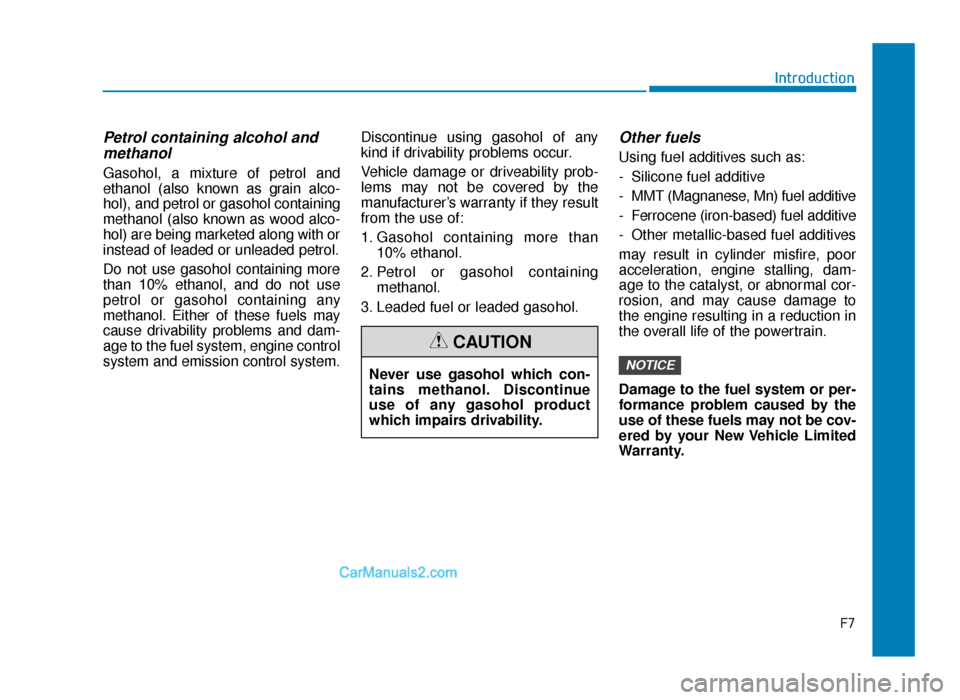
F7
Introduction
Petrol containing alcohol andmethanol
Gasohol, a mixture of petrol and
ethanol (also known as grain alco-
hol), and petrol or gasohol containing
methanol (also known as wood alco-
hol) are being marketed along with or
instead of leaded or unleaded petrol.
Do not use gasohol containing more
than 10% ethanol, and do not use
petrol or gasohol containing any
methanol. Either of these fuels may
cause drivability problems and dam-
age to the fuel system, engine control
system and emission control system. Discontinue using gasohol of any
kind if drivability problems occur.
Vehicle damage or driveability prob-
lems may not be covered by the
manufacturer’s warranty if they result
from the use of:
1. Gasohol containing more than
10% ethanol.
2. Petrol or gasohol containing methanol.
3. Leaded fuel or leaded gasohol.
Other fuels
Using fuel additives such as:
- Silicone fuel additive
- MMT (Magnanese, Mn) fuel additive
- Ferrocene (iron-based) fuel additive
- Other metallic-based fuel additives
may result in cylinder misfire, poor
acceleration, engine stalling, dam-
age to the catalyst, or abnormal cor-
rosion, and may cause damage to
the engine resulting in a reduction in
the overall life of the powertrain.
Damage to the fuel system or per-
formance problem caused by the
use of these fuels may not be cov-
ered by your New Vehicle Limited
Warranty.
NOTICENever use gasohol which con-
tains methanol. Discontinue
use of any gasohol product
which impairs drivability.
CAUTION
TLe UK foreword---.qxp 6/19/2018 4:55 PM Page 7
Page 8 of 685
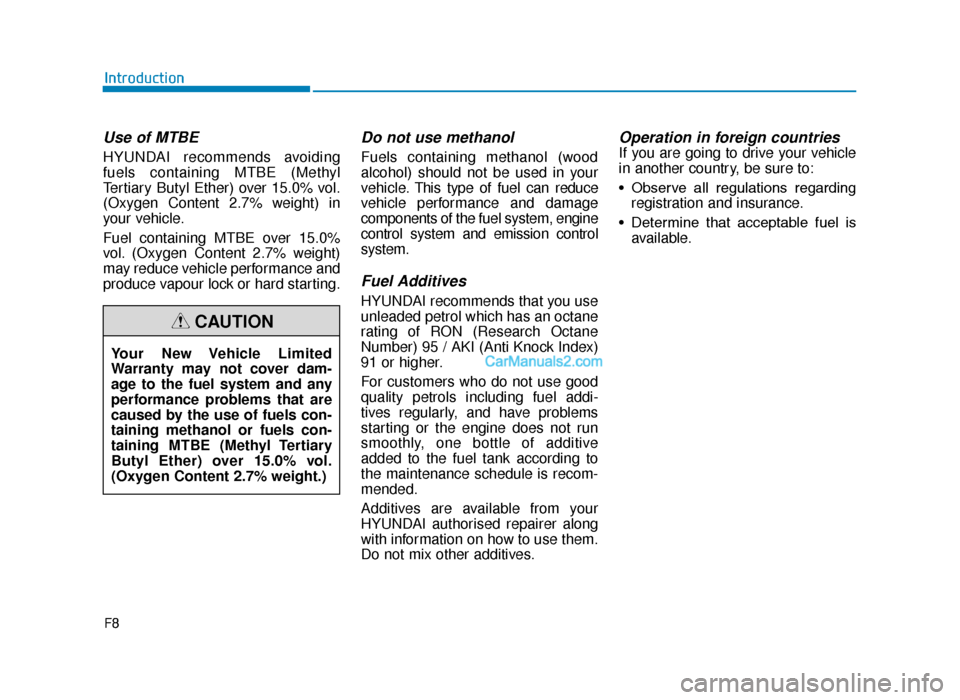
F8
Introduction
Use of MTBE
HYUNDAI recommends avoiding
fuels containing MTBE (Methyl
Tertiary Butyl Ether) over 15.0% vol.
(Oxygen Content 2.7% weight) in
your vehicle.
Fuel containing MTBE over 15.0%
vol. (Oxygen Content 2.7% weight)
may reduce vehicle performance and
produce vapour lock or hard starting.
Do not use methanol
Fuels containing methanol (wood
alcohol) should not be used in your
vehicle.This type of fuel can reduce
vehicle performance and damage
components of the fuel system, engine
control system and emission control
system.
Fuel Additives
HYUNDAI recommends that you use
unleaded petrol which has an octane
rating of RON (Research Octane
Number) 95 / AKI (Anti Knock Index)
91 or higher.
For customers who do not use good
quality petrols including fuel addi-
tives regularly, and have problems
starting or the engine does not run
smoothly, one bottle of additive
added to the fuel tank according to
the maintenance schedule is recom-
mended.
Additives are available from your
HYUNDAI authorised repairer along
with information on how to use them.
Do not mix other additives.
Operation in foreign countries
If you are going to drive your vehicle
in another country, be sure to:
• Observe all regulations regarding registration and insurance.
• Determine that acceptable fuel is available.
Your New Vehicle Limited
Warranty may not cover dam-
age to the fuel system and any
performance problems that are
caused by the use of fuels con-
taining methanol or fuels con-
taining MTBE (Methyl Tertiary
Butyl Ether) over 15.0% vol.
(Oxygen Content 2.7% weight.)
CAUTION
TLe UK foreword.qxp 6/19/2018 6:02 PM Page 8
Page 9 of 685
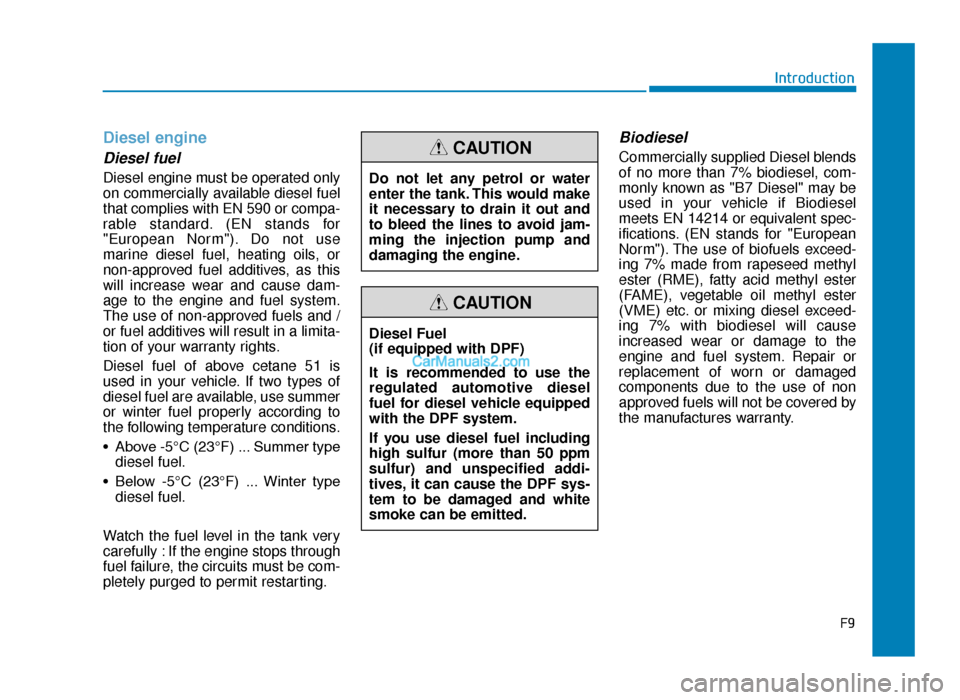
Diesel engine
Diesel fuel
Diesel engine must be operated only
on commercially available diesel fuel
that complies with EN 590 or compa-
rable standard. (EN stands for
"European Norm"). Do not use
marine diesel fuel, heating oils, or
non-approved fuel additives, as this
will increase wear and cause dam-
age to the engine and fuel system.
The use of non-approved fuels and /
or fuel additives will result in a limita-
tion of your warranty rights.
Diesel fuel of above cetane 51 is
used in your vehicle. If two types of
diesel fuel are available, use summer
or winter fuel properly according to
the following temperature conditions.
• Above -5°C (23°F) ... Summer typediesel fuel.
• Below -5°C (23°F) ... Winter type diesel fuel.
Watch the fuel level in the tank very
carefully : If the engine stops through
fuel failure, the circuits must be com-
pletely purged to permit restarting.
Biodiesel
Commercially supplied Diesel blends
of no more than 7% biodiesel, com-
monly known as "B7 Diesel" may be
used in your vehicle if Biodiesel
meets EN 14214 or equivalent spec-
ifications. (EN stands for "European
Norm"). The use of biofuels exceed-
ing 7% made from rapeseed methyl
ester (RME), fatty acid methyl ester
(FAME), vegetable oil methyl ester
(VME) etc. or mixing diesel exceed-
ing 7% with biodiesel will cause
increased wear or damage to the
engine and fuel system. Repair or
replacement of worn or damaged
components due to the use of non
approved fuels will not be covered by
the manufactures warranty.
F9
Introduction
Do not let any petrol or water
enter the tank. This would make
it necessary to drain it out and
to bleed the lines to avoid jam-
ming the injection pump and
damaging the engine.
CAUTION
Diesel Fuel
(if equipped with DPF)
It is recommended to use the
regulated automotive diesel
fuel for diesel vehicle equipped
with the DPF system.
If you use diesel fuel including
high sulfur (more than 50 ppm
sulfur) and unspecified addi-
tives, it can cause the DPF sys-
tem to be damaged and white
smoke can be emitted.
CAUTION
TLe UK foreword---.qxp 6/19/2018 4:55 PM Page 9
Page 10 of 685
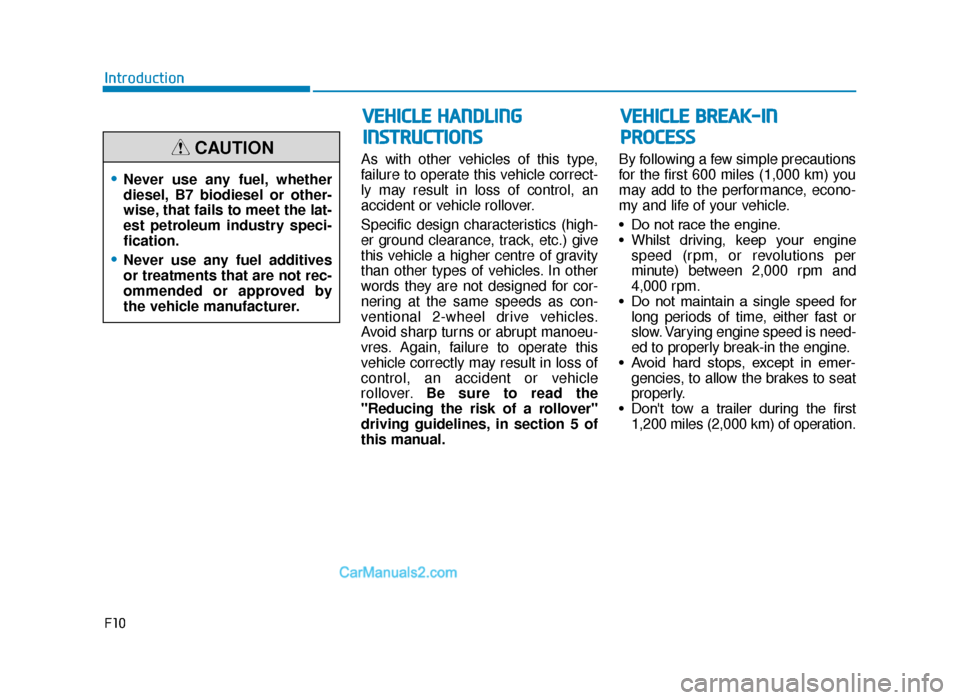
As with other vehicles of this type,
failure to operate this vehicle correct-
ly may result in loss of control, an
accident or vehicle rollover.
Specific design characteristics (high-
er ground clearance, track, etc.) give
this vehicle a higher centre of gravity
than other types of vehicles. In other
words they are not designed for cor-
nering at the same speeds as con-
ventional 2-wheel drive vehicles.
Avoid sharp turns or abrupt manoeu-
vres. Again, failure to operate this
vehicle correctly may result in loss of
control, an accident or vehicle
rollover.Be sure to read the
"Reducing the risk of a rollover"
driving guidelines, in section 5 of
this manual. By following a few simple precautions
for the first 600 miles (1,000 km) you
may add to the performance, econo-
my and life of your vehicle.
• Do not race the engine.
• Whilst driving, keep your engine
speed (rpm, or revolutions per
minute) between 2,000 rpm and
4,000 rpm.
• Do not maintain a single speed for long periods of time, either fast or
slow. Varying engine speed is need-
ed to properly break-in the engine.
• Avoid hard stops, except in emer- gencies, to allow the brakes to seat
properly.
• Don't tow a trailer during the first 1,200 miles (2,000 km) of operation.
F10
Introduction
•Never use any fuel, whether
diesel, B7 biodiesel or other-
wise, that fails to meet the lat-
est petroleum industry speci-
fication.
•Never use any fuel additives
or treatments that are not rec-
ommended or approved by
the vehicle manufacturer.
CAUTION
VEHICLE HANDLING
INSTRUCTIONS
VEHICLE BREAK-IN
PROCESS
TLe UK foreword---.qxp 6/19/2018 4:55 PM Page 10
Page 645 of 685
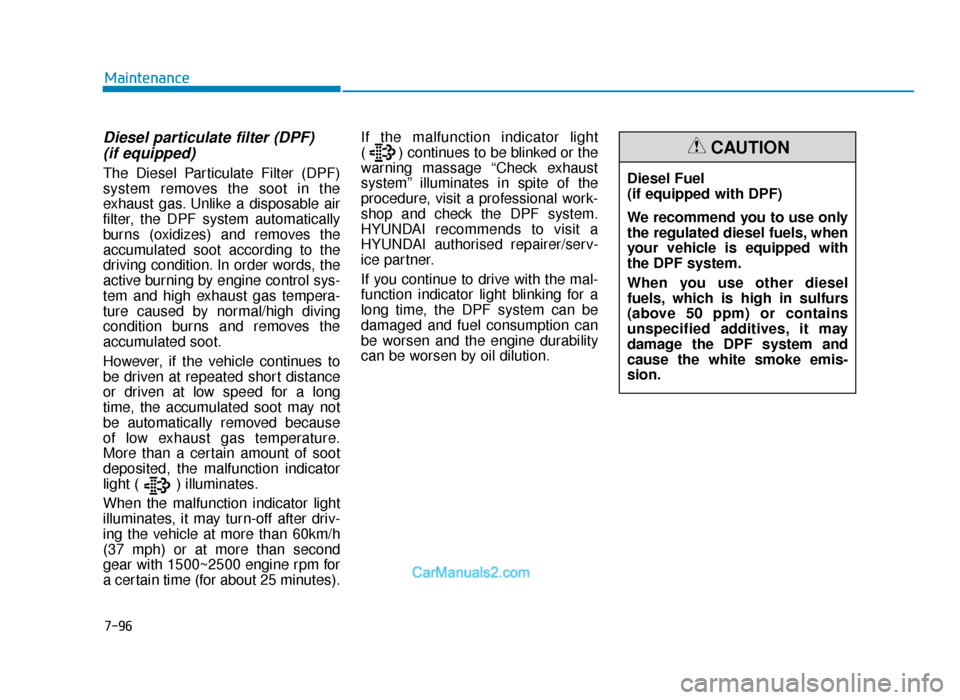
7-96
Maintenance
Diesel particulate filter (DPF) (if equipped)
The Diesel Particulate Filter (DPF)
system removes the soot in the
exhaust gas. Unlike a disposable air
filter, the DPF system automatically
burns (oxidizes) and removes the
accumulated soot according to the
driving condition. In order words, the
active burning by engine control sys-
tem and high exhaust gas tempera-
ture caused by normal/high diving
condition burns and removes the
accumulated soot.
However, if the vehicle continues to
be driven at repeated short distance
or driven at low speed for a long
time, the accumulated soot may not
be automatically removed because
of low exhaust gas temperature.
More than a certain amount of soot
deposited, the malfunction indicator
light ( ) illuminates.
When the malfunction indicator light
illuminates, it may turn-off after driv-
ing the vehicle at more than 60km/h
(37 mph) or at more than second
gear with 1500~2500 engine rpm for
a certain time (for about 25 minutes). If the malfunction indicator light
( ) continues to be blinked or the
warning massage “Check exhaust
system” illuminates in spite of the
procedure, visit a professional work-
shop and check the DPF system.
HYUNDAI
recommends to visit a
HYUNDAI authorised repairer/serv-
ice partner.
If you continue to drive with the mal-
function indicator light blinking for a
long time, the DPF system can be
damaged and fuel consumption can
be worsen and the engine durability
can be worsen by oil dilution.Diesel Fuel
(if equipped with DPF)
We recommend you to use only
the regulated diesel fuels, when
your vehicle is equipped with
the DPF system.
When you use other diesel
fuels, which is high in sulfurs
(above 50 ppm) or contains
unspecified additives, it may
damage the DPF system and
cause the white smoke emis-
sion.
CAUTION
TLe UK 7.qxp 6/12/2018 2:51 PM Page 96
Page 651 of 685
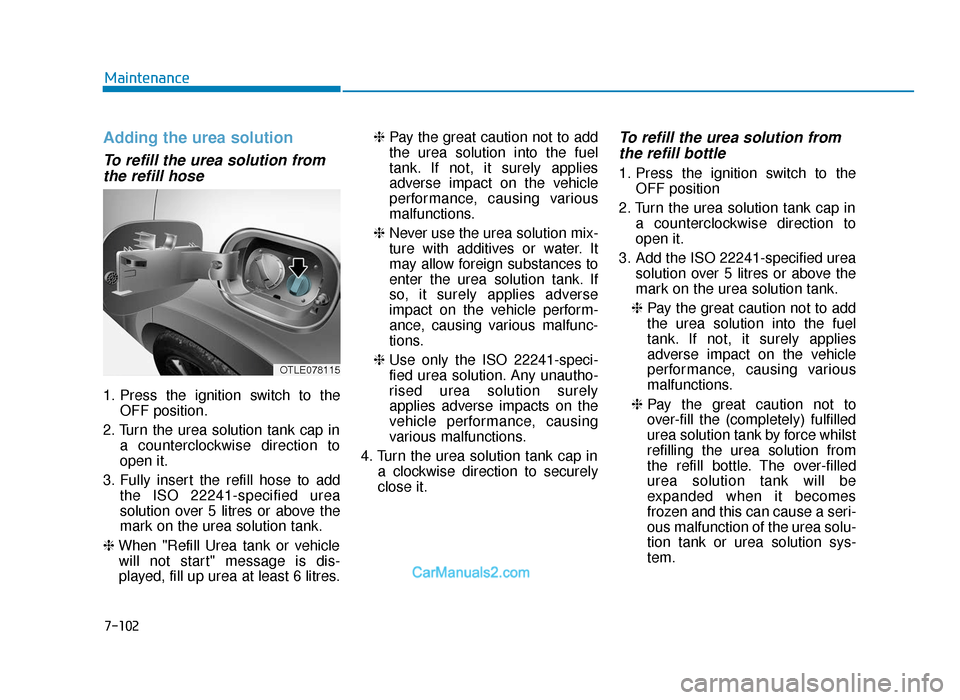
Adding the urea solution
To refill the urea solution fromthe refill hose
1. Press the ignition switch to the
OFF position.
2. Turn the urea solution tank cap in a counterclockwise direction to
open it.
3. Fully insert the refill hose to add the ISO 22241-specified urea
solution over 5 litres or above the
mark on the urea solution tank.
❈ When "Refill Urea tank or vehicle
will not start" message is dis-
played, fill up urea at least 6 litres. ❈
Pay the great caution not to add
the urea solution into the fuel
tank. If not, it surely applies
adverse impact on the vehicle
performance, causing various
malfunctions.
❈ Never use the urea solution mix-
ture with additives or water. It
may allow foreign substances to
enter the urea solution tank. If
so, it surely applies adverse
impact on the vehicle perform-
ance, causing various malfunc-
tions.
❈ Use only the ISO 22241-speci-
fied urea solution. Any unautho-
rised urea solution surely
applies adverse impacts on the
vehicle performance, causing
various malfunctions.
4. Turn the urea solution tank cap in a clockwise direction to securely
close it.
To refill the urea solution fromthe refill bottle
1. Press the ignition switch to the
OFF position
2. Turn the urea solution tank cap in a counterclockwise direction to
open it.
3. Add the ISO 22241-specified urea solution over 5 litres or above the
mark on the urea solution tank.
❈ Pay the great caution not to add
the urea solution into the fuel
tank. If not, it surely applies
adverse impact on the vehicle
performance, causing various
malfunctions.
❈ Pay the great caution not to
over-fill the (completely) fulfilled
urea solution tank by force whilst
refilling the urea solution from
the refill bottle. The over-filled
urea solution tank will be
expanded when it becomes
frozen and this can cause a seri-
ous malfunction of the urea solu-
tion tank or urea solution sys-
tem.
7-102
Maintenance
OTLE078115
TLe UK 7.qxp 6/12/2018 2:51 PM Page 102
Page 653 of 685
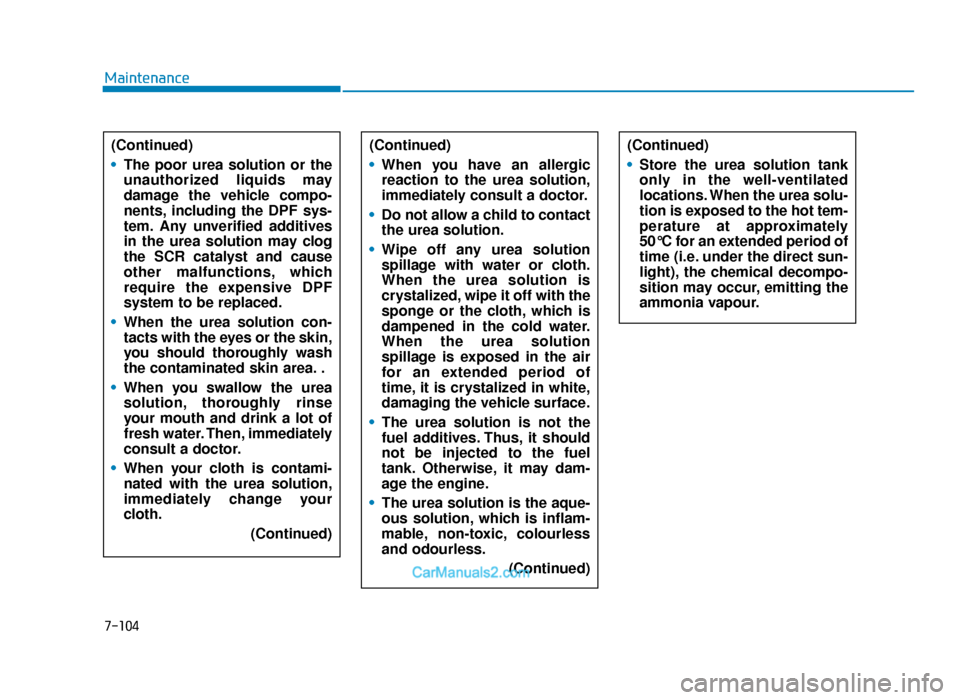
7-104
Maintenance(Continued)
• The poor urea solution or the
unauthorized liquids may
damage the vehicle compo-
nents, including the DPF sys-
tem. Any unverified additives
in the urea solution may clog
the SCR catalyst and cause
other malfunctions, which
require the expensive DPF
system to be replaced.
• When the urea solution con-
tacts with the eyes or the skin,
you should thoroughly wash
the contaminated skin area. .
• When you swallow the urea
solution, thoroughly rinse
your mouth and drink a lot of
fresh water. Then, immediately
consult a doctor.
• When your cloth is contami-
nated with the urea solution,
immediately change your
cloth.
(Continued)
(Continued)
•When you have an allergic
reaction to the urea solution,
immediately consult a doctor.
• Do not allow a child to contact
the urea solution.
• Wipe off any urea solution
spillage with water or cloth.
When the urea solution is
crystalized, wipe it off with the
sponge or the cloth, which is
dampened in the cold water.
When the urea solution
spillage is exposed in the air
for an extended period of
time, it is crystalized in white,
damaging the vehicle surface.
• The urea solution is not the
fuel additives. Thus, it should
not be injected to the fuel
tank. Otherwise, it may dam-
age the engine.
• The urea solution is the aque-
ous solution, which is inflam-
mable, non-toxic, colourless
and odourless.
(Continued)(Continued)
•Store the urea solution tank
only in the well-ventilated
locations. When the urea solu-
tion is exposed to the hot tem-
perature at approximately
50°C for an extended period of
time (i.e. under the direct sun-
light), the chemical decompo-
sition may occur, emitting the
ammonia vapour.
TLe UK 7.qxp 6/12/2018 2:51 PM Page 104
Page 654 of 685
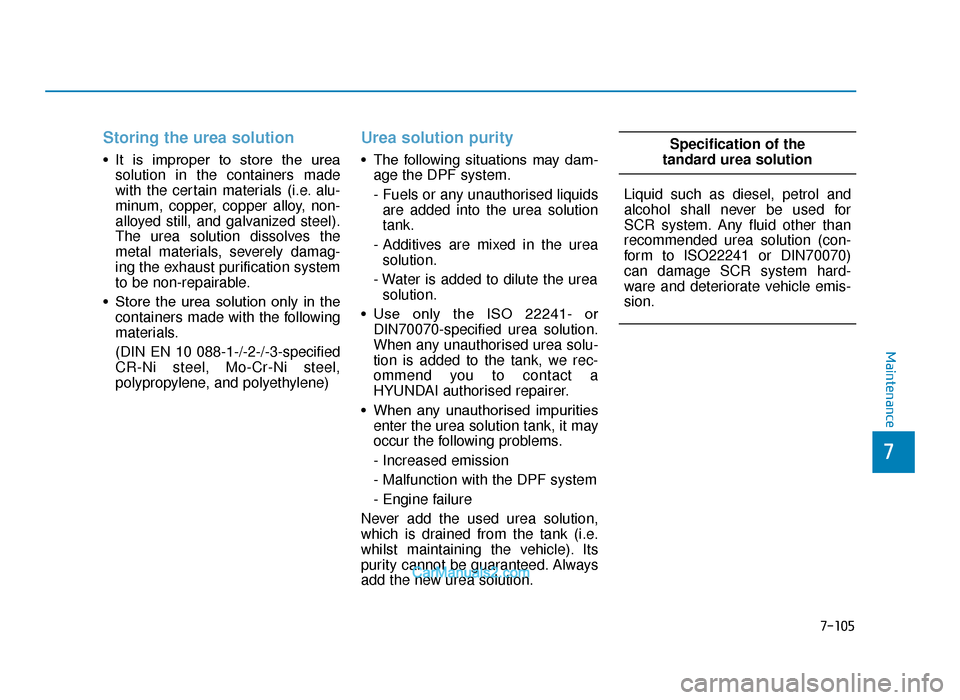
Storing the urea solution
• It is improper to store the ureasolution in the containers made
with the certain materials (i.e. alu-
minum, copper, copper alloy, non-
alloyed still, and galvanized steel).
The urea solution dissolves the
metal materials, severely damag-
ing the exhaust purification system
to be non-repairable.
• Store the urea solution only in the containers made with the following
materials.
(DIN EN 10 088-1-/-2-/-3-specified
CR-Ni steel, Mo-Cr-Ni steel,
polypropylene, and polyethylene)
Urea solution purity
• The following situations may dam-age the DPF system.
- Fuels or any unauthorised liquidsare added into the urea solution
tank.
- Additives are mixed in the urea solution.
- Water is added to dilute the urea solution.
• Use only the ISO 22241- or DIN70070-specified urea solution.
When any unauthorised urea solu-
tion is added to the tank, we rec-
ommend you to contact a
HYUNDAI authorised repairer.
• When any unauthorised impurities enter the urea solution tank, it may
occur the following problems.
- Increased emission
- Malfunction with the DPF system
- Engine failure
Never add the used urea solution,
which is drained from the tank (i.e.
whilst maintaining the vehicle). Its
purity cannot be guaranteed. Always
add the new urea solution.
7-105
7
Maintenance
Specification of the
tandard urea solution
Liquid such as diesel, petrol and
alcohol shall never be used for
SCR system. Any fluid other than
recommended urea solution (con-
form to ISO22241 or DIN70070)
can damage SCR system hard-
ware and deteriorate vehicle emis-
sion.
TLe UK 7.qxp 6/12/2018 2:51 PM Page 105